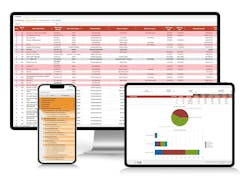Streamlining Construction Procurement: Benefits of Job Order Contracting
Construction procurement presents a variety of challenges for owners managing contractors. Common issues owners face include a lack of centralized platforms to manage contractors and contracts, inconsistent bidding processes that fail to ensure competitiveness, insufficient transparency on fees paid for work performed, and a lack of tracking or ability to audit.
Beginning in the latter part of the 20th century, Job Order Contracting (JOC) was first used by the US Army. JOC is an indefinite delivery, indefinite quantity (IDIQ) construction procurement method aimed at simplifying the contracting process. JOC facilitates competitively awarded work order-based contracts that reduce or even eliminate extra steps inherent in traditional procurement processes, saving time and resources. By creating a transparent and competitive environment, JOC enhances procurement and project management efficiency.
An Arizona State University study found impressive user satisfaction with JOC, revealing 87% of projects completed on time and 91% within budget. Cost savings averaged 24% with a remarkable 75% reduction in procurement time.1
Users of JOC find one of greatest advantage is in the reduction of contracts and solicitations required for construction projects. For example, one contract solicitation can replace 15 to 30 single solicitations.
Under JOC, work orders for construction projects are governed using a unit price book (UPB) – that helps develop line-item proposals tailored to specific scopes of work. Each line item includes equipment, materials, and labor costs necessary to complete measurable tasks, ensuring that pricing reflects actual conditions and wage rates specific to a client or region. A well-sourced UPB provides:
- Greater efficiency in the proposal development and review process
- Reduced time starting and completing work orders
- Greater transparency into proposal costs associated with defined scope of work
- Reduced opportunity for quantity and price inflation by contractors
- Overall greater ability to maintain a transparent and auditable JOC program
Implementing a JOC program offers distinct advantages. It creates significant time savings in competitive construction procurement, compressing the timeline between project scope development and notice to proceed from months to as little as a few weeks or days. This up-front competitive bidding and contracting process, completed when awarding master contracts, streamlines project management.
Overcoming Common Challenges: Transparency, Efficiency, and Accountability
JOC provides transparency in contractor pricing. The submitted adjustment factors encompass the contractors’ operational costs, including general conditions, overhead, and profit margins. Consequently, owners gain enhanced insight into the costs associated with each work order.
While public entities such as federal and local government agencies, K-12 school districts, university systems, and public health care providers are the primary users of JOC, there is potential for private sector application.
Successful JOC implementation is characterized by clear communication strategies, well-defined roles, and regular performance monitoring. It often begins with establishing accountability through designated roles, such as program administrator and JOC coordinator. Successful contractor management requires comprehensive outreach that emphasizes education, communication, and quality-based procurement practices. Collaborative partnerships fostered through regular team meetings and sessions enhance project outcomes.
Harnessing Technology: How JOC Software Transforms Project Management
Using software designed to support a JOC program and automate much of the workflow delivers significant benefits in contract management, project tracking, and cost estimating. Centralized management features help streamline operations, while real-time data facilitated through interactive dashboards supports informed decision making and continuous improvement.
Effective JOC software should include a comprehensive UPB tailored to local conditions, automated cost estimating capabilities, and dedicated support from account managers and experts. Primary considerations include ensuring the system is configurable to the client’s needs and seamlessly integrates with existing information management platforms. These elements enable organizations to manage the entire JOC workflow efficiently, enhancing collaboration and ensuring compliance with procurement standards.
When establishing a JOC program, there is no one-size-fits-all solution. Local conditions, codes, and prevailing wages, among other variables, point to the need for a platform that is as agile and responsive as it is comprehensive.
In choosing JOC software, organizations should prioritize several essential features:
- Centralized Management: to keep contract management, project tracking, and cost estimating organized and accessible
- Data Informed Decision Making: for real-time tracking of program performance
- Robust Cost Estimating Tool: to ensure accuracy tailored to local market conditions
- Dedicated Support: to assist throughout the project life cycle
- Additional functionality, such as invoicing, change order tracking, and digital documentation, further enhance the JOC program by promoting efficiency and transparency.
Look for software that supports the following:
- Certification and Contracting
- Simplifies contractor certification by centralizing client provided information for faster assessment and tracking.
- Streamlines contract management with easy contract creation and compliance through digitization.
- Work Order Issuance
- Enables online job order creation, defining scope, location, and specifications seamlessly.
- Integrates predefined unit prices for instant pricing, avoiding manual calculations.
- Cost Estimation and Approval
- Automates cost estimation using platform unit prices for consistent pricing.
- Facilitates real-time approvals and workflow, speeding up the process and reducing delays.
- Work Execution
- Enhances project scheduling and resource management, ensuring effective task execution.
- Promotes communication and collaboration among project stakeholders for real-time updates.
- Change Management
- Tracks supplemental orders easily, documenting scope changes and updates for quick approvals.
- Sends notifications to stakeholders for improved transparency.
- Final Inspection and Acceptance
- Allows digital documentation and inspections, eliminating paper records.
- Provides real-time inspection feedback for efficient job order closures.
- Invoicing and Payment
- Features automated invoicing based on completed work, reducing errors.
- Tracks payments in real time, providing detailed financial reports to minimize delays.
- Close-Out and Post-Completion
- Supports organization of close-out documents for easier project completion.
- Enables contractor performance evaluations for future project insights.
Ultimately, JOC software should be adaptable with your agency in mind. Working with your KPIs to ensure your JOC program meets your needs, your clients' needs, and as a public provider, your taxpayers' needs.
At the forefront of revolutionizing the job order contracting field is FOS (Facility Optimization Solutions), a leading provider in the industry, renowned for its client-centric approach and multidisciplinary expertise in facility optimization. FOS proudly boasts a ranking as the #1 worldwide provider of facility-related services in addition to having successfully supported nearly $400 million in JOC projects.
The Simplebid® platform is a comprehensive job order contracting (JOC) program management solution that includes software, cost data, and professional support from industry experts (from basic software support all the way to full CM services). FOS created Simplebid® alongside some of the largest JOC programs in the country to develop a solution that prioritizes user-friendliness and adapts to diverse requirements.
Simplebid® is designed to be intuitive and configurable, with each installation tailored to organizational process and workflows. Supported by in-house programmers and data analysts, Simplebid® includes interactive reports and dashboards that can be generated or accessed on-demand from any device.
For more information on ways FOS of CannonDesign can assist you, reach out to: [email protected] or visit our website at www.foscd.com.
1 Kashiwagi, Dean T., et al. Job Order Contracting Performance: 2015 Industry Survey. Performance Based Studies Research Group (PBSRG), Del E. Webb School of Construction, Arizona State University, Feb. 2016.



